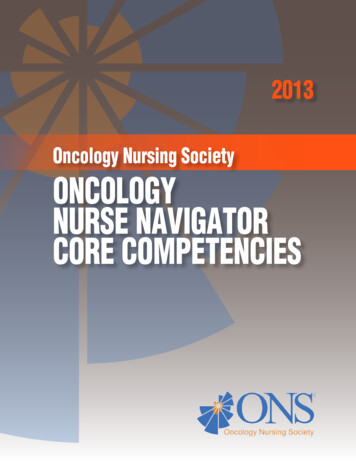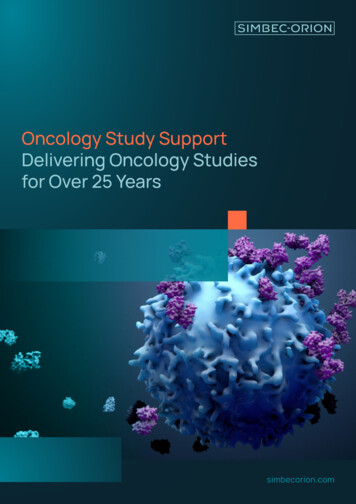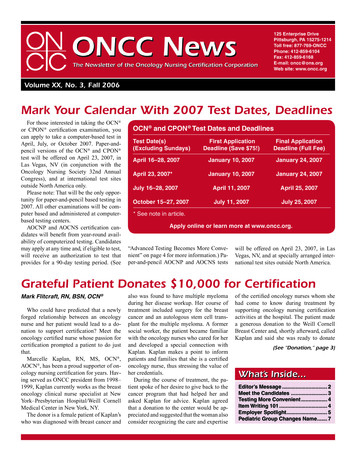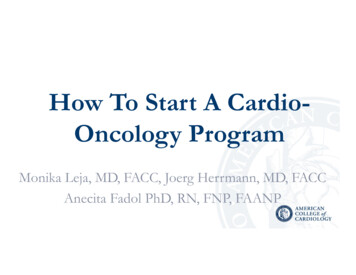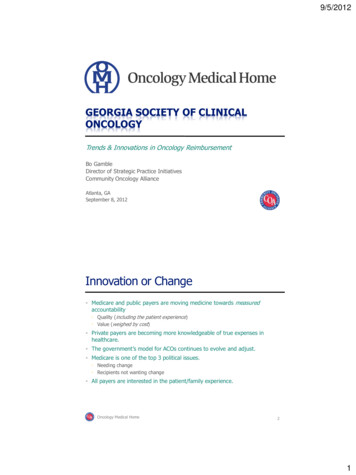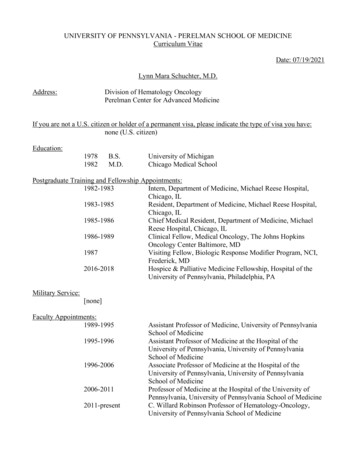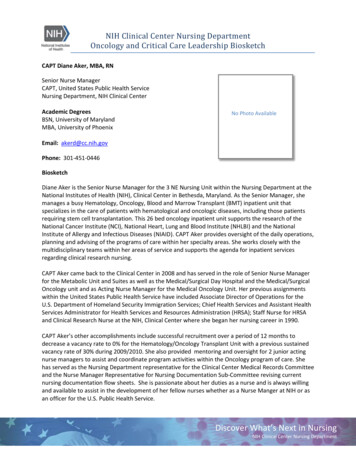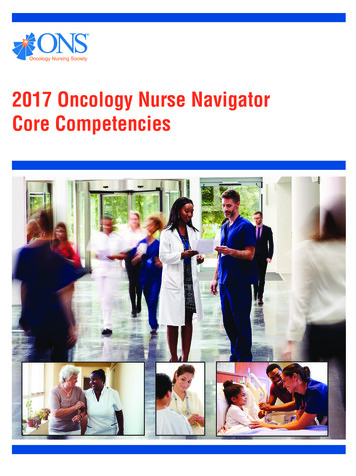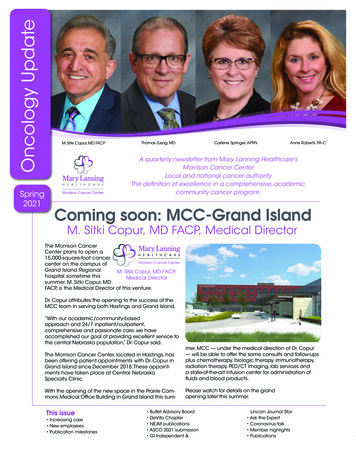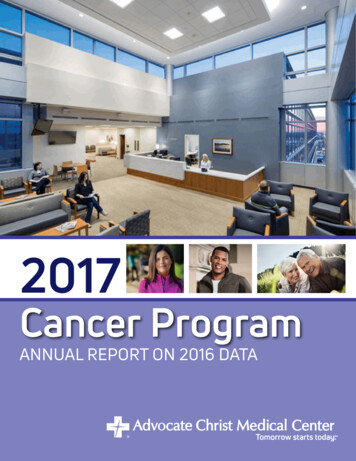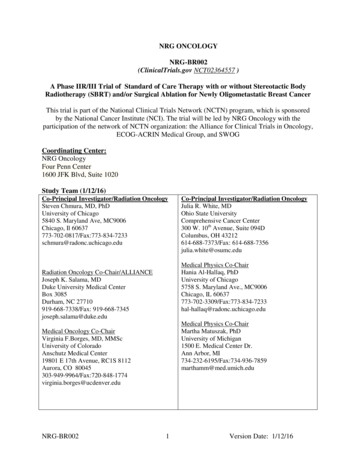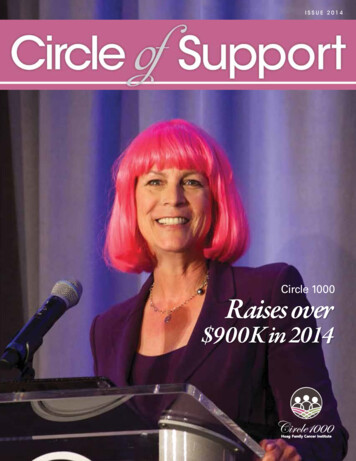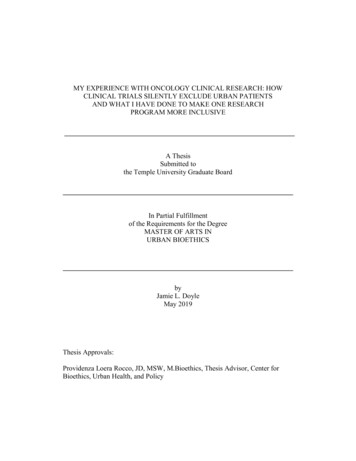
Transcription
MY EXPERIENCE WITH ONCOLOGY CLINICAL RESEARCH: HOWCLINICAL TRIALS SILENTLY EXCLUDE URBAN PATIENTSAND WHAT I HAVE DONE TO MAKE ONE RESEARCHPROGRAM MORE INCLUSIVEA ThesisSubmitted tothe Temple University Graduate BoardIn Partial Fulfillmentof the Requirements for the DegreeMASTER OF ARTS INURBAN BIOETHICSbyJamie L. DoyleMay 2019Thesis Approvals:Providenza Loera Rocco, JD, MSW, M.Bioethics, Thesis Advisor, Center forBioethics, Urban Health, and Policy
ABSTRACTAs an oncology clinical researcher at an urban hospital, I reflected on patient stories andsee overlying themes: financial hurdles, treatment delays, difficulties completingtreatment, ineligibility for clinical trials, and other barriers to care specific to urbanpatients. Delays in cancer treatment have been linked to a decrease in overall survival;consequently, reducing observed blockades could be a matter of life and death. Clinicaltrials provide more treatment options while researching possible standard of care therapiesfor future patients. As novel anticancer treatments become more biomolecule specific andlow minority enrollment on clinical trials used to validate these drugs continues, I ask,“Why”? I believe urban patients are unethically excluded from participating in clinicaltrials by overly restrictive study eligibility criteria, high out-of-pocket costs, lengthyinformed consents written either not at the patient’s reading level or not in their language,as well as other deterrents associated with low socioeconomic status. More minorityrepresentation in clinic trials is necessary to ensure drugs seeking FDA approval are morerepresentative of the population. I argue more needs to be done to make studies moreinclusive. Though challenges enrolling urban patients onto clinical trials remains, I believethere are still ways to enhance their cancer care: 1) identifying or writing treatment clinicaltrials that are more inclusive; and 2) developing studies with interventions that targetsocioeconomic barriers to care.ii
I dedicate my work to:the man who inspired my passion for creativity and cancer research, my father, Jimmy,the man who loves, encourages, and supports me in my continuous search for knowledgeand adventure, Mike,and the girl I am determined to leave a brighter future for, my daughter, Amelia Jules.iii
TABLE OF CONTENTSABSTRACT. iiLIST OF TABLES . vLIST OF FIGURES . viPROLOGUE . viiMalik . viiNillie . xRamsey. xiiMargarita . xiiiCHAPTER 1: INTRODUCTION . 1Temple University Hospital Community Needs Assessment . 1Bioethics . 9CHAPTER 2: ONCOLOGY CLINICAL TRIALS . 14Minorities in Clinical Trials . 14How Clinical Trials Exclude Urban Patients . 15CHAPTER 3: BUILDING A RESEARCH PROGRAM AT TUH . 20Study to Warrant a Cancer Center Designated Financial Counselor . 23Study to Justify Pharmacist Interventions as Standard of Care . 29Other Studies in Development Focused on Urban Cancer Patients. 32CHAPTER 4: CONCLUSION . 34EPILOGUE . 35REFERENCES . 37iv
LIST OF TABLESTablePage1. Demographics of TUH Service Area . . . 22. Socioeconomics Measures Comparing TUH Residents toPhiladelphia and Montgomery Counties . . . . 33. Reproductive Health Status Comparing TUH Residents toPhiladelphia and Montgomery Counties . . 64. Percentage of Clinical Trials Excluding Patients due toComorbidities Associated with Urban Populations . . 175. Pilot Study Results: Modified InCharge Financial Distress/Financial Well-Being Scale . . . . 26v
LIST OF FIGURESFigurePage1. Map of TUH Service Area . . 22. Mortality Rates by Area . . . 43. Mortality Rates: Top Causes of Death by Area . . 54. Mortality Rates: Cancer Diagnosis by Area . . 55. Persons Living with HIV/AIDS and Hepatitis by Area . . 66. Health Conditions and Risk Factors . . 77. Limitations with IADLs and ADLs . . . 88. Persons with No Health Insurance or Prescription Drug Coverage 89. Self Reported Health Status . 910. Factors that Influence Socioeconomic Status . 1211. Health Equality verse Health Equity . 1312. Number of Patients Accrued to Studies by Year 2113. Number of Protocols Open to Accrual by Year . 2214. Protocol Phases Open to Accrual in 2019 . 2215. Patient Insurance Coverage: Pilot Financial Distress Study . 27vi
PROLOGUEEthics. Saying the word may take your mind to a philosophical plane – analyzingtopics through a detached lens – removed from social, emotional, and personalinteractions. Bioethics is different as it dives right into those interactions and focuses onthe how topics affect people. Narrowing the scope even more so, urban bioethicsilluminates ethical problems specific to the urban population. Understanding how urbanpatients are silently excluded from clinical trials begins with the philosophical termembodiment. Embodiment refers to how the environment and consciousness mold thebody, while also giving an outside observer a focal point to better understand things inrelation to a particular body (Moran, 2010). To grasp the idea that urban patients aresilently excluded from clinical trials, we must define how environment has molded thebodies of people living in the city and readjust our perception to see things in relation tothese bodies. I would like to open with a few stories to give more context to the ethicaldilemmas I intend to discuss. * Afterall, what is the purpose of bioethics if we cannot put aface to it?MalikMalik, a 23-year-old, Black, male, living in North Philadelphia, had a sore throatthat had been bothering him for months. He did not think much of it, passing it off asirritation from the environment – a few abandoned buildings were being knocked downin his neighborhood. This happened pretty often, so he was used to his throat feeling alittle scratchy, plus he frequently had mouth sores, so this was nothing new. He ignored it*Note: names and details have been changed to protect the identity of the patientsvii
until one morning he woke up and realized his tonsils were the size of a grape. Nowconcerned he had tonsillitis and would have to miss work, he went to the emergencyroom. He did not have a family doctor and he did not have insurance. His jobs in foodservice, Uber, and Lyft afforded him a humble place to live plus living expenses. He hadday-to-day fears of violence, keeping a roof over his head, having clothes to wear,making sure he had food to eat, and keeping a cell phone. He never thought about thefuture – not even tomorrow – so he never thought about his overall health. Reluctantly,Malik agreed to a scan and a biopsy. A week later he was diagnosed with tonsil cancer.This news set him on a new course for the unknown, and he did not have any socialsupport at the time to navigate.He underwent surgery to have the mass removed but did not fully understand theadditional steps needed to keep the cancer at bay. “They cut it out, so I’m good! I gottago back to work!” The surgeon explained that he had some positive lymph nodes, so hewould require additional therapy. Not understanding the urgency to start adjuvanttreatment right away, Malik went back to focusing on the day-to-day and figured maybehe would follow-up about further treatment eventually. After months of missingappointments for work, the surgeon convinced him to meet with the medical andradiation oncologist. They explained that since his tonsil cancer was associated withhuman papillomavirus (HPV), it most likely would not come back as long as hecompleted all the required treatment in the specified timeframe and started right away.The physicians put together a standard of care treatment plan where he would receiveconcurrent chemotherapy and radiation for seven weeks: chemotherapy once a week;radiation Monday thru Friday every week. They mapped out the schedule so he could doviii
radiation early before he went to work and scheduled chemotherapy on his day off, but hewould also need to meet with other services twice a week to help manage his symptomsalong the way: speech therapy to help manage oral mucositis and his ability to swallowand nutrition to make sure he was getting enough nourishment.He consented to participate in a Phase III clinical trial that hoped to prevent oralmucositis in patients receiving chemoradiation for oral cancers, a common unfortunateside effect for which there is currently no ideal treatment. Sadly, he was found ineligibledue to having a history of smoking marijuana even though he had not done so in twoyears. The study also required extra biopsies and scans that were not covered by thesponsor, meaning he would be required to pay for them out-of-pocket if he was eligiblefor the study. Since Malik was unable to receive the clinical trial oral mucositis treatment,he was prescribed the approved mouthwashes in hopes that is would prevent oralmucositis as long as possible.Prior to starting treatment, he was instructed to meet with a dentist so that anyteeth that were loose or decayed could be removed prior to starting radiation. Sinceradiation to the mouth would affect the gums, poor quality teeth could fall out if theywere not already removed. That would change the shape of the oral cavity, meaning theradiation treatment beams would need to be remapped in the middle of treatment, causingdelay and uncertainty that all of the tissue with tumor burden received the correct dose ofradiation. Patients tend to need multiple teeth extracted; Malik was no different. He hadnot been to a dentist since he was 8-years-old, so his teeth were full of decay requiring allof his teeth to be removed. Being in his early 20’s, it took about two months to convinceMalik of the importance of the full-mouth extraction, “I don’t wanna look old.” When heix
ultimately agreed, the dentist was not able to see him for another month. Then the day ofhis scheduled visit, there was a long wait, so Malik left to go to work. A month later, hewas finally able to meet with the dentist for surgery and was ready to start treatment thefollowing week.Hospital services were able to help him get insurance and transportation to hisappointments, but he still frequently missed treatment visits due to needing to work extrahours, no social support, problems with managing oral mucositis symptoms, and beingoverwhelmed by all his appointments: medical oncology, radiation oncology, radiology,ENT surgery, nutrition, speech therapy, dental, and more. He developed a severe oralmucositis and was unable to eat. The physicians recommended a feeding tube, but Malikdid not want to do that. After only receiving three cycles of chemotherapy andintermittent radiation, Malik stopped going to treatment. Eight months later, hereconnected with an old friend from his youth who just moved back to town. His friendconvinced him to continue cancer treatment and offered to support him; Malik was ableto move in with this friend so he could focus on finishing cancer treatment instead ofworking.NillieNillie was a 70-year-old, Black, female, who took care of her 100-year-oldmother, her 20-year-old granddaughter, and her 2-year-old great-grandson who all livedwith her. She continued to work in customer service with the same company for 40 years;and, when her job changed insurance companies this year, she opted for the best coveragebecause she always wanted to be prepared. Little did she think she would be diagnosedwith rectal cancer – she just thought her hemorrhoids were acting up and went to herx
doctor who encouraged her to have her first colonoscopy. The American Cancer Societyrecommends colorectal cancer screening to begin at age 50, but Nillie refused to have acolonoscopy until now. When the colonoscope revealed a lesion, she underwent furthertesting to determine if it was cancer. The lesion was biopsied and she was sent for bloodwork and scans. It wasn’t until she got her first CT scan that she realized her insurancehad high out-of-pocket costs. Each CT scan had a 500 out-of-pocket co-pay forcingNillie work extra hours to pay for it.Discussing her full cancer work-up with the medical oncologist, Nillie found outshe had Stage III Rectal Cancer, for which the standard of care treatment is chemoradiation, followed by surgery, then more chemotherapy. Unfortunately, if she had acolonoscopy sooner, the cancer may have been found at an earlier stage that required lesstreatment. She desperately wanted to participate in a clinical trial because it providedtreatment without her having to have a colostomy bag, which would make it easier for herto continue to take care of her family while undergoing cancer therapy. She wasconcerned about the number of scans she would need to receive, plus after enrollment tothe clinical trial, it turned out her insurance would not cover certain treatment aspects ofthe study – home infusion of chemotherapy and a more precisely targeted modulatingdose of radiation to the tumor. Now fearful she would need to commit to the standard ofcare treatment involving the colostomy bag or not get treatment at all, Nillie was referredto the hospital’s financial counseling office to assist with acquiring new insurance.Initiation of her treatment was delayed until this process was complete, and since there isnot currently a financial counselor designated to the cancer center, the process took about6 weeks as the counselors manage cases for the entire hospital. However, once her newxi
insurance was approved, the study treatment plan was covered as standard of care and herco-pays for CT scans were 25.RamseyRamsey, an active Peruvian man, was first diagnosed with Stage III prostatecancer when he was 53-years old, at which time he had surgery followed by radiation andchemotherapy. Since other components of the tumor eluded that he was at a high risk ofrecurrence and he was a relatively younger patient, the physician recommended him to goon hormone therapy to help reduce the amount of testosterone in his body, providingtumor cells with less of a food supply, and hoping that would reduce the chance of thecancer returning. This type of therapy involves a quick injection every three months,which is much more manageable than daily radiation or even chemotherapy infusion forthree hours every three weeks. Although, the time commitment is not hefty, hormonetherapy for prostate cancer has side effects that include erectile dysfunction, hot flashes,and possibly gynecomastia. It is a drug that chemically castrates the body by severelyreducing the testosterone without actually having a surgical castration. Lamentably,Ramsey experienced all of the above side effects and reported a terrible quality of life, sohe opted to discontinue hormone deprivation therapy and go on active surveillanceinstead – which is also a standard of care option for prostate cancer patients who havehad curative treatment. Ramsey would continue to see the physician every 3-6 monthswhere he would get blood work to check the Prostate Specific Antigen (PSA) levels inhis blood (a blood biomarker in prostate cancer) and occasionally CT scans.Now 59-years old, Ramsey was informed that his PSA blood levels were elevatedto a level concerning for metastatic disease, so the physician scheduled him for CT andxii
bone scans. The scans showed some abnormalities in his bones, so Ramsey was sent for abone biopsy, which was found to be positive for metastatic disease favoring prostatecancer. The physician presented multiple treatment options, including a Phase III clinicaltrial; the standard of care options included going back on the hormone therapy that he hada problem with before or continuing on observation, waiting until the PSA rose higher tostart treatment. Ramsey preferred the clinical trial since it did not involve getting thehormone; instead a different drug would be used that did not have the same side effects,so he consented to participate in the study. An eligibility review determined he wasineligible to participate in the study because he had a history of hypertension and type 2diabetes, even though he was very compliant with his medication and maintained ahealthy blood pressure and glucose levels. Documentation was submitted to the sponsorshowing consistently good blood glucose levels and blood pressure levels hoveringaround 118/75 for the prior 10 years without changes to either medications. The sponsorreplied that they had a few other complaints about the eligibility criteria, but they werefirm in refusing enrollment to the clinical trial if a person had a history of high bloodpressure and/or diabetes, even if it was controlled. Disappointed he was not allowed toparticipate in the clinical trial, Ramsey chose to remain on surveillance rather thanresuming hormone therapy because he did not want to endure the side effects again.MargaritaMargarita was a 48-year old Black, Puerto Rican woman who felt somethingdifferent in her breast one day during a self-breast exam, so she decided to have her firstmammogram. Even though the gold standard is to start having mammographs at age 40,she thought she did not need to have one done unless she felt an abnormality in herxiii
breast. The test discovered a mass, and a few weeks later, a biopsy showed the mass to becancerous with negative biomarkers for estrogen-receptor (ER), progesterone-receptor(PR), and human epidermal growth factor receptor 2 (HER2). Otherwise known as “triplenegative” breast cancer, ER/PR/HER2 negative breast cancer patients have been shownto have shorter progression free survival and poorer overall survival overall whencompared to breast cancer patients with other ER/PR/HER2 statuses. The reason why isthat if a tumor is found to have a positive biomarker, which means that hormone isfeeding the tumor. A medical oncologist would be guided to design a treatment plan thatwould include drug that target that hormone receptor, which would in turn decrease thetumor’s food supply and help the tumor to shrink.Being a Spanish-speaking patient, Margarita chose to come to TUH for treatment;a friend from her church told her that the TUH cancer center had bilingual staff,physicians, and nurse navigator that could help direct her care comfortably in her ownlanguage. During her appointments with medical oncology and radiation oncology, thephysicians explained her cancer diagnosis and the different treatments available for it,including a clinical trial. Margarita really wanted to participate in the clinical trial, but itturned out the informed consent document was only available in English. She begged thephysicians and the study team to let her participate in the clinical trial anyway, so thestudy team put in a request to have the document translated, not realizing the uphill battleahead of them. Margarita scheduled to return to clinic one week later with the hopes ofconsenting to study.The study team’s request for a Spanish informed consent document was ignoredfor a few days. After persistently contacting the regulatory department in charge of suchxiv
documents, the study team was told the request had been forwarded to upper managementfor approval. Knowing the form would not be obtained in time for the scheduledappointment, her bilingual physician contacted her to give her the option to reschedulefor a week later or start traditional chemotherapy – she opted to wait for the clinical trial.Over the next week, the study team had multiple conference calls with uppermanagement that involved members of the business operations and budgetary teams. Theargument was “who was going to pay for the translation?” Frustratingly, the sponsorsupplied a template of the informed consent document in Spanish when the study wasopened, which included why the study was being done, a description of the studytreatment, possible risks, a section about how the study was voluntary and that patientscould withdraw at any time, and other required elements of an informed consentdocument. It was the institution’s responsibility to add contact information and oneparagraph on the patient’s right if injured while on study. Learning that the delay was dueto financing the additional wording, which was determined to be a 200 cost, thephysician sought approval for the medical oncology department to fund the translationsince the research department was reluctant to. The medical oncology departmentdetermined that the funding should come from the research department, so meetings werescheduled between the departmental leaders. Meanwhile, Margarita’s appointment wasdelayed yet again.The physician again contacted Margarita to let her know that there were stillchallenges getting the informed consent translated and again offered to begin standard ofcare therapy, but Margarita again opted to wait for the translation – she was determinedto be on the clinical trial. Accordingly, the physician pleaded with the researchxv
department to provide some means for the patient to consent to study, noting that she wasunethically being excluded from participation. After another week, it was decided that thepatient would be able to consent by signing a one-page short form written in Spanishwhich stated that the English informed consent document was verbally translated to herusing the language line and upon listening she consents to participate in the study. Thisone-page form was approved by the Institutional Review Board (IRB) and was made thestandard when consenting non-English speaking patients until further discussions couldbe held on whether to provide the translated full-length consent document. Margarita wasamenable to signing the one-page form and went on to participate in the clinical trial totreat her breast cancer.xvi
CHAPTER 1: INTRODUCTIONThese stories represent just a small fraction of patients I have interacted withduring my career in oncology clinical research. As I reflect on other stories I havewitnessed, common themes emerge: financial barriers, delays in starting treatment,inability to complete standard of care treatment once started, ineligibility to participate inclinical trials to comorbidities and risk factors predominantly associated with urbanpatients, difficulties obtaining study documents in a patient’s native language, and more.Elements of those themes will appear throughout this thesis, so it will be important topause and reflect on how those factors contribute to the bioethical concern of excludingurban cancer patients from participating in clinical trials. I challenge the reader to keepMalik, Nillie, Ramsey, and Margarita in their mind while I unwrap the multiple layers ofthis problem. Trudging through numerous barriers to receive access to cancer therapyultimately causes delays in treatment; studies have linked treatment delays to poor overallsurvival (Tsai, Kung, Wang, Huang, & Liu, 2017). Imagine what differences could beseen in their health and in their stories if they were not living in North Philadelphia.Temple University Hospital Community Needs AssessmentTemple University Hospital (TUH) services residents in the North PhiladelphiaArea. Calculation determined that about 75% of those who were inpatients reside in thefollowing zip codes (combined population 633,031): 19111, 19120, 19121, 19122,19124, 19125, 19132, 19133, 19134, 19138, 19140, 19141, 19144, and 19149 (PublicHealth Management Corporation, Community Health Data Base, 2016).
Figure 1Map of TUH Service AreaTable 1Demographics of TUH Service AreaDemographics% (n 633,031)Age0-1718-4445-6465 27392311RaceBlack47Latino24White21Asian6Language SpokenEnglish72(Public Health Management Corporation, Community Health Data Base, 2016)2
The 2016 TUH Community Needs Assessment analyzed socioeconomics,mortality, morbidities, and more to determine the areas of the greatest need within thecommunity. Those living in the TUH service area (TUH Residents), Philadelphia, andMontgomery Counties were compared to depict many unmet needs felt by TUHResidents (Public Health Management Corporation, Community Health Data Base,2016). Considerable differences were found in the socioeconomics of persons over theage of 25 when reviewing education, employment, poverty rate, and household income; itshowed TUH Residents in the poorest group in each category:Table 2Socioeconomics Measures Comparing TUH Residents to Philadelphia and MontgomeryCountiesSocioeconomic MeasuresTUHPhiladelphia MontgomeryResidentsCountyCountyEducation%%%Advance Degrees132646High School Education Only625748Employment%%%Unemployment Rate20167Poverty Rate%%%Families with Children29224Families without Children29226Household Income Median 30,048 36,553 80,561(Public Health Management Corporation, Community Health Data Base, 2016)Studies have shown that those with lowest socioeconomic status (SES) havelower health literacy, engage in more unhealthy behaviors (i.e. smoking), are more3
focused on present problems (paying bills) than future (how unhealthy behaviors couldaffect health), and as such have a lower life expectancy (Wardle & Steptoe, 2003). Whencomparing the health of TUH Resident to those in Philadelphia and Montgomery County,much like what was seen in SES, TUH Residents fair the poorest in each category –mortality, health, and risk factors. To start, TUH Resident had a higher overall mortalityrate:Figure 2Mortality Rates by Area1200957Rate per 100,00010008938006646004002000TUH ResidentsPhiladelphiaCountyMontgomeryCounty(Public Health Management Corporation, Community Health Data Base, 2016)TUH Resident ranked higher than Philadelphia and Montgomery County for each of thetop causes of death:4
Figure 3Mortality Rates: Top Causes of Death by AreaRate per 100,000250222 21220016916515015310010052 45503246 45 4128 23140All CancersHeart DiseaseTUH ResidentsAccidentsPhiladelphia CountyStrokeDiabetesMontgomery County(Public Health Management Corporation, Community Health Data Base, 2016)An analysis of cancer related deaths showed the number one cause of death to be lungcancer followed by prostate, breast, colorectal, then cervical cancer:Figure 4Mortality Rates: Cancer Diagnosis by Area7060 58Rate per 100,000605042403021 20201004428 2936 342320141CervicalTUH ResidentsColorectalFemale BreastPhiladelphia CountyLungProstateMontgomery County(Public Health Management Corporation, Community Health Data Base, 2016)5
Table 3Reproductive Health Status Comparing TUH Residents to Philadelphia and MontgomeryCountiesReproductive Health StatusFertility Rates (live births/1,000)Ages 15-44Teen Pregnancy (%)Ages 15-17Infant Statistics (Per 1,000 live births)Low Birth WeightMortality RateTUHResidentsPhiladelphia ic Health Management Corporation, Community Health Data Base, 2016)TUH Resident data was unavailable; however, Philadelphia had a higher rate of personsliving with HIV/AIDS and Hepatitis B and C compared to Montgomery County:Figure 5Rate per 100,000Persons Living with HIV/AIDS and Hepatitisby Area70605040302010059463137206HIV/AIDSHepatitis BPhiladelphia CountyHepatitis CMontgomery County(Public Health Management Corporation, Community Health Data Base, 2016;Philadelphia Department of Public Health, 2019).The TUH service area has a higher rate of chronic physical and mental health conditionsand tobacco use:6
Figure 6Rate per 100,000Health Conditions and Risk Factors403530252015105036 342523242014HypertensionAsthma AdultTUH Residents15 ladelphia County12Depression Tobacco UseMontgomery County(Public Health Management Corporation, Community Health Data Base, 2016).Social aspects of health reviewed activities of daily living, health insurancecoverage, and self-reported overall health status. Instrumental Activities of Daily Living(IADLs) are defined as activities related to independent living (the ability to use atelephone, shop, cook, clean, manage finances, and take medications); whereas, Activitiesof Daily Living (ADLs) are defined as self-care activities (grooming, dressing, eating,bathing, walki
the Temple University Graduate Board . In Partial Fulfillment . . URBAN BIOETHICS . by . Jamie L. Doyle . May 2019 . Thesis Approvals: Providenza Loera Rocco, JD, MSW, M.Bioethics, Thesis Advisor, Center for Bioethics, Urban Health, and Policy . ii . ABSTRACT . . BUILDING A RESEARCH PROGRAM AT TUH. 20 Study to Warrant a Cancer Center .
